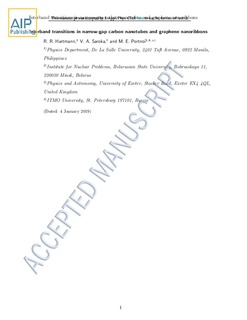| dc.contributor.author | Hartmann, R.R. | |
| dc.contributor.author | Saroka, Vasil | |
| dc.contributor.author | Portnoi, M.E. | |
| dc.date.accessioned | 2019-04-12T07:01:51Z | |
| dc.date.available | 2019-04-12T07:01:51Z | |
| dc.date.created | 2019-04-09T17:23:49Z | |
| dc.date.issued | 2019 | |
| dc.identifier.citation | Journal of Applied Physics. 125, 151607 (2019) | nb_NO |
| dc.identifier.issn | 0021-8979 | |
| dc.identifier.uri | http://hdl.handle.net/11250/2594357 | |
| dc.description.abstract | We use the robust nearest-neighbor tight-binding approximation to study the same footing interband dipole transitions in narrow-bandgap carbon nanotubes (CNTs) and graphene nanoribbons (GNRs). It is demonstrated that curvature effects in metallic single-walled CNTs and edge effects in gapless GNRs not only open up bandgaps, which typically correspond to THz frequencies, but also result in a giant enhancement of the probability of optical transitions across these gaps. Moreover, the matrix element of the velocity operator for these transitions has a universal value (equal to the Fermi velocity in graphene) when the photon energy coincides with the bandgap energy. Upon increasing the excitation energy, the transition matrix element first rapidly decreases (for photon energies remaining in the THz range but exceeding two bandgap energies, it is reduced by three orders of magnitude), and thereafter it starts to increase proportionally to the photon frequency. A similar effect occurs in an armchair CNT with a bandgap opened and controlled by a magnetic field applied along the nanotube axis. There is a direct correspondence between armchair GNRs and single-walled zigzag CNTs. The described sharp photon-energy dependence of the transition matrix element, together with the van Hove singularity at the bandgap edge of the considered quasi-one-dimensional systems, makes them promising candidates for active elements of coherent THz radiation emitters. The effect of Pauli blocking of low-energy interband transitions caused by residual doping can be suppressed by creating a population inversion using high-frequency (optical) excitation. | nb_NO |
| dc.language.iso | eng | nb_NO |
| dc.publisher | AIP Publishing | nb_NO |
| dc.title | Interband transitions in narrow-gap carbon nanotubes and graphene nanoribbons | nb_NO |
| dc.type | Journal article | nb_NO |
| dc.type | Peer reviewed | nb_NO |
| dc.description.version | acceptedVersion | nb_NO |
| dc.source.volume | 125 | nb_NO |
| dc.source.journal | Journal of Applied Physics | nb_NO |
| dc.source.issue | 15 | nb_NO |
| dc.identifier.doi | 10.1063/1.5080009 | |
| dc.identifier.cristin | 1691211 | |
| dc.description.localcode | This is the authors’ accepted and refereed manuscript to the article. This article may be downloaded for personal use only. Any other use requires prior permission of the author and AIP Publishing. The following article appeared in Journal of Applied Physics 125, 151607 (2019) and may be found at https://aip.scitation.org/doi/10.1063/1.5080009. | nb_NO |
| cristin.unitcode | 194,66,20,0 | |
| cristin.unitname | Institutt for fysikk | |
| cristin.ispublished | true | |
| cristin.fulltext | postprint | |
| cristin.qualitycode | 1 | |
